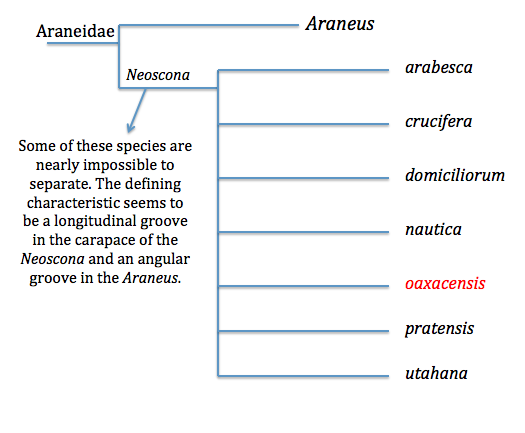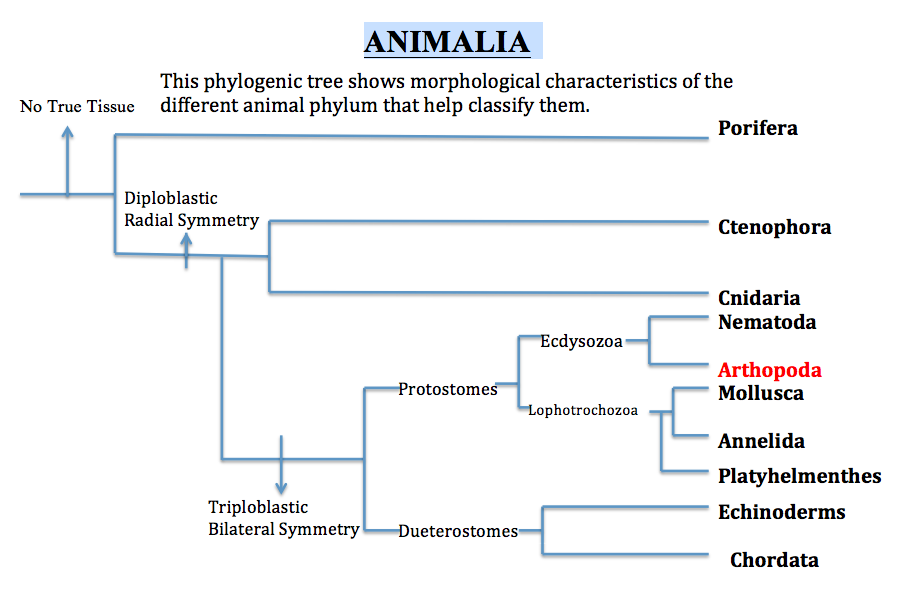Classification
Domain: Eukarya
~ Organisms of this domain have
membrane-bound organelles and a true nucleus.
This separates them from the bacteria and
archaea. These organisms do not contain a water
vacuole or chloroplasts as found in many plant
species. An example of a plant species like this
would be the
Actinidia deliciosa or kiwifruit.
Check it out!
![]()
Kingdom: Animalia
~ Instead of possessing a cell wall as can be
seen in many plant species, for example the
Ananas comosu or
![]() .
This kingdom only has a plasma membrane
surrounding their cells. All animals are motile
at some point in their life cycles.
.
This kingdom only has a plasma membrane
surrounding their cells. All animals are motile
at some point in their life cycles.
Phylum: Arthropoda
~ Arthropods have an exoskeleton that is
segmented and composed of chitin. To grow this
phylum goes through the process of ecdysis, or
molting. This process is why Arthropods are
classified as ecdysozoans along with nematodes,
an example of a nematode being,
![]() .
These organisms are triploblastic meaning that
they have three layers of tissue. They have
muscles attached to jointed appendages that
allow for movement in two directions. Members
of this phylum also have open circulatory
systems and a true coelom. Another example of an
arthropod with an open circulatory system is the
.
These organisms are triploblastic meaning that
they have three layers of tissue. They have
muscles attached to jointed appendages that
allow for movement in two directions. Members
of this phylum also have open circulatory
systems and a true coelom. Another example of an
arthropod with an open circulatory system is the
![]() ,
also known as a crane fly.
,
also known as a crane fly.
Class: Arachnida
~ This class contains the joint-legged invertebrate animals. All arachnids have 8 legs. The word arachnid is derived from a Greek word meaning "spider" (Bartlett 2004).
Order: Araneae
~These spiders are air breathing
arthropods with 8 legs and fangs that inject venom.
This order of organisms have a cephalothorax and an
abdomen. Another key character is that they have a
chelicerae that is used to grasp food and is
connected to their venom gland (Balaban 2005). If
you are interested in learning more about species in
this order I encourage you to check out the zebra
spider,
![]() .
.
Family: Araneidae
~ The well known orb-weaving spiders belong
to this family (Pascoe 1980). They create the well
known spiral shaped webs and have 8 eyes. To
learn more about another type of orb-weaver my prior
classmates check out the
![]() .
.
Genus: Neoscona
~ This genus is particularly known having a longitudinal groove on the carapace which separates all Neoscona from Araneus (Pascoe 1980).
Species: Oaxacensis
Unfortunately I could not find the Latin meaning of this species name. However the common name is the western spotted orb-weaver. If anyone can inform me of the Latin meaning I encourage you to email me.
~ The Neoscona arabesca can be separated from oaxacensis by the three pairs of dorsal, slanting, dark spots found on the arabesca. This species stays in its retreat to the side of the web during the day. At night it rests in the center of the web with the tip of the abdomen pushed through the open space in the center of the web (Sensenig et al. 2011).
This next tree shows the relationship of the closest orb-weaving
genus to the Neoscona and the key characteristics that
can be used to separate the two.
Click here to continue on to learn about the species:


